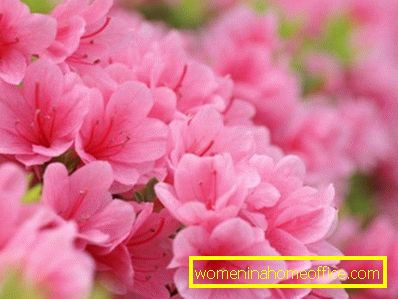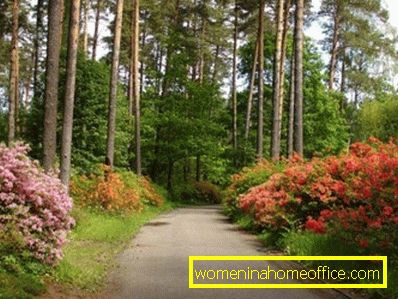How to care for rhododendron
Rhododendrons - amazing ornamental shrubs, shrubs, less trees. There are evergreen species, there are deciduous. A variety of colors of rhododendron inflorescences can not but cause admiration. They bloom well even in the shade of big trees. Look great singly, in small groups along the tracks and on the slopes. Stunted areas of your garden can be decorated with stunted species.
Description of rhododendron
Rhododendrons are grown here as shrubs or shrubs. The leaves of different species are very diverse in size, shape, degree of pubescence. Flowers are also diverse in size, shape and color. They are collected in umbellate or corymbose inflorescences. There are species with single flowers or collected in inflorescence of two. The color of the inflorescences is very diverse. These are various shades of pink, this is red, burgundy, yellow, lilac, cream, white, purple-violet.

Kinds rhododendron
For growing rhododendron in our climatic conditions, the following types are recommended.
- Tree Rhododendron- deciduous upright shrub, height up to three meters. It blooms in late June - early July. The flowers are collected in groups of 3-6, white with a pink tinge.
- Rhododendron- deciduous shrub, height up to two meters. It blooms in July. Flowers are collected in five, orange-crimson color.
- Japanese Rhododendron- Deciduous strongly shrubby shrub, height up to 1-2 meters. The flowers are collected on 6-12, orange-red, salmon-red or brick-red with a yellowish-orange spot, as well as golden-yellow. It blooms in June.

- Rhododendron gummy- deciduous, up to three meters. The flowers are sticky to the touch, collected on 4-9. It blooms in June and early July with white or pinkish flowers.
- Rhododendron attractive - evergreen creeping shrub, height up to one and a half meters. Flowers solitary, collected in two or three, large, purple-violet. It blooms in June. Forms carpet thickets under the trees.
In addition to these five, 17 more types of rhododendron are recommended.
Growing up rhododendron
For reproduction of rhododendron, seed reproduction and vegetative reproduction are used.
To grow a plant from seed, the following is necessary. In early March, seeds are sown in picking boxes. Usually the seeds are mixed with sand, as they are very small. Contain crops at a temperature of 20 ° C. They are covered with film or glass and aired every day for several minutes (remove the film or glass) so that mold does not appear. Water is poured over with rain or thawed snow at room temperature, carefully, as necessary. At the stage of unfolded cotyledons, seedlings dive at a distance of three centimeters. After three weeks, the seedlings are fed with physiologically acidic mineral fertilizers (potassium sulphate or ammonium, superphosphate).

You can take out all summer boxes on the balcony. Seedlings are fed twice a month until the second picking. The second pick is done in August. Plants are placed at a distance of four centimeters. The composition of the soil should be sour, bezvesvestkovym. For the winter, the boxes are transferred to the premises, kept at a temperature of 8 ° C. By spring, it is gradually increased to 20 ° C. In late May, seedlings are planted in the open ground.
For cultivation of rhododendron in the open field use the following soil mixtures: heather, leaf earth and coarse sand (3: 1: 1) or peat moss peat, turf ground and coarse sand (4: 1: 1). The mixture must be sifted through a large sieve. If you sift through the shallow, then such a land when watering will not pass air.
Rhododendron is propagated by vegetative means. There are four such methods: cutting, dividing the bushes, grafting and reproduction by layering. To learn how to propagate rhododendron in any of these ways, read the article "Plum".
Pests and diseases rhododendron
With proper care (moderate watering, regular weeding and feeding), problems with pests usually do not arise.
Rhododendron can affect diseases like gray rot and azalea septoria. Gray rot occurs due to poor ventilation of rooms, high humidity and insufficient heat. Sick plants are destroyed so that healthy people do not get infected. The land is disinfected.
The causes of Septoria azaleas are the same, plus the lack of light in the winter. Control measures include airing the rooms, collecting and burning diseased leaves. It is useful to spray in the measures of prevention with a suspension of captan (0.5%) or 80% zineb (0.4%).

See also:How to grow young?
Rhododendrons are unusually beautiful shrubs. They can decorate your garden paths in the country. They look good one by one and with other species of rhododendron or other plants. They are well decorated with rocky places of your garden, various flower beds, slides. Creeping, low rhododendron species can grow well in the shade of large deciduous or coniferous trees.
The extraordinary beauty of the inflorescences and flowers, the great diversity of cultural species, as well as the wide possibilities of their use in the garden, explain the enormous popularity of rhododendron.